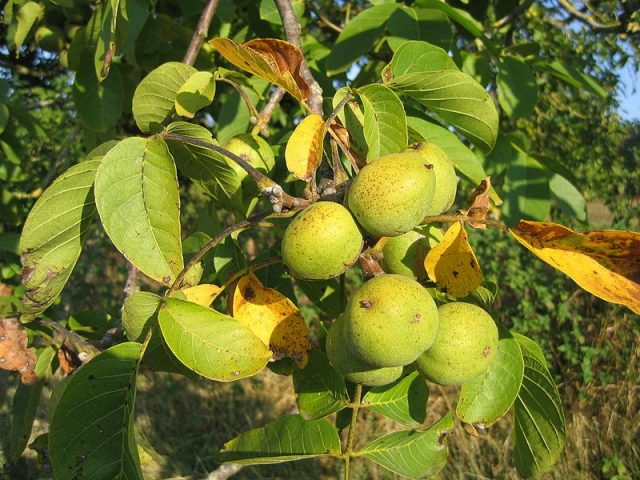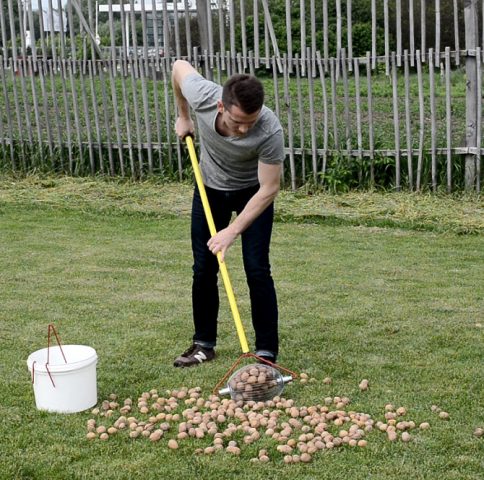Content
The birthplace of the walnut is Central Asia. The tree appeared on the territory of Russia thanks to Greek traders, hence the corresponding name - walnut. Walnuts grow almost all over the world. It is successfully cultivated in Belarus, Moldova, Russia, Ukraine and the Caucasus. Hazel gained popularity due to the beneficial properties of its fruits, green mass and bark.
Where does the walnut grow?
The nut grows almost everywhere: some varieties are perfectly suited for planting in the northern regions. Some species can tolerate prolonged frosts and are practically immune to insect pests. The preferred growing location is in well-lit, spacious, non-wetland areas.Hazel grows quickly at higher elevations and in loamy soils.
Where do walnuts grow in the world?
The tree grows in places with a temperate climate, however, it prefers the southern regions. Wild plantings can be seen in the Transcaucasus and in the Talysh Mountains. Often wild hazel grows in the moist gorges of the Himalayas. Nuts are specially grown in China, India, Austria, and Greece. Planting is practiced in gardens in Germany and Italy.
Walnut forest plantations can be seen in the Tien Shan mountains, in Uzbekistan, Kyrgyzstan and Tajikistan. These forests are considered the largest in the world.
Where do walnuts grow in Russia?
Trees are common in the middle zone; they are also regularly planted in the southern regions of Russia. They practice planting in the Moscow and Leningrad regions. In the northern regions, cultivation is worse. The tree does not tolerate prolonged low temperatures, the maximum limit is 30 degrees below zero.
Breeders are developing varieties that can grow for long periods of time at very low temperatures. But in most cases, such seedlings practically do not bear fruit.
Do walnuts grow in the Moscow region?
Walnuts are successfully grown in the Moscow region. The tree grows in gardens and park areas. The state register of selection achievements contains more than 25 varieties that take root well in this area. The trees tolerate frost well, and in summer they can withstand prolonged absence of watering.
It should be remembered that planting each seedling has its own agricultural technology and characteristics.Proper care will help you grow a strong tree with high productivity.
In the Moscow region, it is recommended to plant seedlings away from drafts. In the first years of life, the main trunk is fragile, so it can break off in strong winds. The best option for landing would be a well-lit area near buildings. When planting in a summer cottage, you should pay attention to the fact that during the growth process the tree shades a large area, so vegetable crops must be planted away from the nut.
How does a walnut grow and ripen?
Walnuts grow for a very long time and are long-lived. Therefore, at the age of 25–45 years, the seedling is considered young and is in the juvenile period. The peculiarity of the nut is that the quantity and quality of the harvest increases with age.
Walnut grows and develops well under optimal climatic conditions. Tolerates dry weather and not severe frosts. However, returning frosts are dangerous for the seedling. Spring sharp temperature changes are detrimental to vegetation. The main shoots and leaves are damaged, which later affects the yield. Over time, new branches form, but this takes a lot of time.
The period of fruit ripening on the tree is August – September, rarely – October. The exact harvest period depends on the region of growth and the variety planted.
There are several types:
- early;
- mid-early;
- late.
Each species has differences in the flowering period and final fruiting. For each region, the appropriate variety should be selected.
What does a walnut tree look like?
During the period of active development and growth, the walnut tree forms a wide trunk, reaching 30 m in height and 2 m in diameter. The color of the bark is grayish-white, the crown is dense and wide with a large number of branches. The root is powerful, goes deep into the ground by more than 7 m. The lateral root system is quite long - more than 10 m.
The alternate leaves are compound, imparipinnate. The length of the plate is 5–7 cm. A green mass with a peculiar aroma, during flowering it looks very attractive. The flowers are small, green, and collected in neat earrings. Flowering period: late April - early May, duration - 2 weeks. Late-ripening varieties may have buds that bloom again in mid-summer. Pollination occurs with the help of wind or pollen from nearby plants.
Walnuts grow on spreading trees, the crown diameter of which is about 20 m. The fruits are hard, brown in color, and have a four-lobed seed covered with a thin film. The peel is green in color, dense in structure, slightly wrinkled and lumpy.
How long does it take for a walnut to grow?
Walnut grows for a long time - the tree is long-lived. When planted in optimal climatic conditions, it can grow and bear fruit well for up to 600 years. Wild trees in forest areas can live for more than 1,200 years.
How long does a walnut grow before fruiting?
The period of full growth and development of the plant depends on the variety. On early ripening species, the first fruits appear 3–6 years after planting. Mid-ripening and late-ripening ones take at least 10 years to grow and develop before the first fruiting. From 10–12 years of life, a tree can produce from 1 to 5 kg of harvest per season. Mature trees that have reached 50–60 years of age bear fruit abundantly.
How fast does a walnut grow?
Mid-season and late varieties grow for quite a long time and can often survive more than one host. Early ripening trees grow much faster, but such species require some care.
How many nuts does a walnut produce?
During the season, from one walnut tree you can get from 15 to 350 kg of quality harvest. This indicator may vary depending on the age of the tree, region of growth and quality of care. A seedling that is about 10 years old bears fruit little by little - a maximum of 5 kg of fruit per year.
When to Harvest Walnuts
The ripening period for ordinary walnuts occurs in early autumn. The exact harvest time depends on the region in which it is grown. As the harvest ripens, the foliage on the branches becomes dull in color, and the fruits fall to the ground on their own.
It is recommended to familiarize yourself with some signs by which you can determine the exact timing of harvesting:
- cracking of the green pericarp;
- coloring of most leaves yellow;
- Harvest dates can be determined by knowing the varietal characteristics of the plant.
When are walnuts collected in the middle zone?
Growing a plant in the middle zone is a labor-intensive process. In this region, hazel trees bear fruit irregularly. By creating favorable conditions for growth, you can reap a good harvest. The fruits begin to fall from the tree by August, but most of them have poor pericarp separation. The harvested crop is first placed in a dark, cool place, and after full ripening it is well dried in the sun.
When do walnuts ripen in the Krasnodar Territory?
In the Krasnodar Territory, harvesting takes place a little later. Full ripening of walnuts in this region occurs in mid-September. The trees growing in Krasnodar are significantly different from those grown in other regions: they bear fruit abundantly, and the bulk of the harvest is of impressive size.
When does a walnut ripen in Crimea?
Crimea is a region where walnuts are actively grown. Thanks to favorable climatic conditions, the tree grows throughout the Crimea. The fruits are harvested closer to August. However, to avoid damage by rodents and other pests, some gardeners prefer to harvest much earlier. Unripe fruits with green pericarp are knocked down with a stick and left to dry in the sun. After a couple of days, the peel is easily separated, then dried.
How to tell if a walnut is ripe
When harvest time comes, the fruits begin to fall from the tree. It should be remembered that the tree ripens and grows unevenly, so harvesting is not carried out in 1–2 days; sometimes this process drags on for weeks. After the ripened fruits have fallen to the ground, it is recommended to collect them within 24 hours, otherwise there is a high probability of damage by rodents and insects.
Another indicator of ripening is cracking of the pericarp. This process can occur directly on the tree. Therefore, the harvesting procedure can be carried out earlier; I used a roll for churning the fruits.
How walnuts are collected
Timely harvesting of ripe crops is a very important task. Having correctly determined the exact timing of ripening, you can begin harvesting the fruits.
Due to the fact that the tree is tall, manual harvesting is a rather labor-intensive process. Often, ripe walnuts are knocked down with a stick or removed with a special roll for collection. The collected fruits are shaken well and cleared of green peel. If the pericarp is poorly separated, the crop is dried in the sun.
Rules for harvesting walnuts:
- Fruits that have fallen to the ground should be collected within 24 hours, otherwise there is a high risk of mold damage to the crop. The earth's moisture destroys the amniotic membrane, and the product begins to spoil.
- If harvesting is done with a stick, ripe nuts and unripe ones in the pericarp may fall to the ground. This crop should be collected in separate containers. Fruits with pericarp should be kept in a basement or cellar for several days.
- If you harvest unripe fruits, you should place the crop in a dark, cool place and wait until it is fully ripe. This procedure must be performed with nuts in which the pericarp does not separate. When the shell begins to separate well from the shell, the crop is fully ripe.
- The walnut crop can be harvested when the protective skin of the fruit begins to crack. To do this, shake the branches of the tree. However, as practice shows, it is quite difficult to knock down most of the nuts using this method, so gardeners resort to using long objects.
- Well-ripened fruits may be damaged if dropped on hard ground. In this case, it is recommended to use special harvesting devices.
Conclusion
Walnuts grow in almost every region. By creating optimal growing conditions for the tree, you can get a bountiful and high-quality harvest. It should be noted that at least 10 years pass from the moment of planting to the first fruiting. During the process of active growth, the tree needs some care. To obtain an early harvest, it is recommended to choose early-ripening varieties adapted to the climatic conditions of the region.













